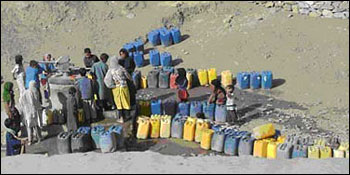

Floods or Famine: Water in Afghanistan | |||
The vegetation images reveal how plants are growing across a wide region, but they aren’t the only things that FEWS NET uses to detect famine. “FEWS NET uses a convergence of evidence,” says Budde. “One thing may tip us off, but we look at many things to determine what is going on.” In addition to the vegetation index maps, FEWS NET tracks rainfall and temperatures over crop areas. They match the weather factors with the growing cycle of the crops being produced to see if rain and sun are coming at the right times in the crops’ development. They project how much water the crops will need and compare that with the amount of water available. They chart the locations of agriculture and rangeland so they know what kind of vegetation is growing in each area. All of this information is combined with information about the people living in the region to predict how they will be affected by a potential crop failure. Experienced in monitoring rainfall and its effects on crops in Africa and Central America, Budde and other FEWS NET scientists immediately faced a new challenge when they began to monitor Afghanistan in 2002. Afghan farmers get their water from melting snow, not rainfall. “When everything came together, we realized that snow cover is of vital importance to water availability for an area,” says Budde. Snow cover was an issue they hadn’t had to consider when monitoring Central America or Africa. |
|||

Like the U.S. West, water in Afghanistan most often falls in the form of mountain snow. The snow pack melts gradually through the spring and summer, supplying irrigated farmland with water through the growing season. Unlike the U.S. West, where an intricate system of reservoirs preserves water so it can be used when crops need it, Afghanistan has limited means to store water. “The infrastructure for irrigation water has been destroyed,” says Budde. Decades of conflict has left canals and reservoirs in rubble. Much of the remaining infrastructure is old and in poor condition. The loss of infrastructure means that snow that melts too early or too quickly can’t be used to water crops later in the season. “More than seventy percent of agriculture is irrigated in Afghanistan,” Budde explains, so if the timing of the snow melt is wrong or snowfall is scarce, a poor harvest and hunger are likely to follow. But how do you monitor snowfall in rugged mountains where roads are hazardous and violence is commonplace? “Ground truth is hard to get in Afghanistan,” Budde agrees. “We are not able to get out in the field as easily as in other countries because of security.” In the absence of ground measurements, remote sensing is crucial. Among those sensors used to monitor snow is the Moderate Resolution Imaging Spectroradiometer (MODIS) on NASA’s Terra satellite. |
Afghanistan residents line up to collect water. Many parts of the country lack adequate water supplies and water storage facilities. (Photo courtesy U.S. Geological Survey) | ||